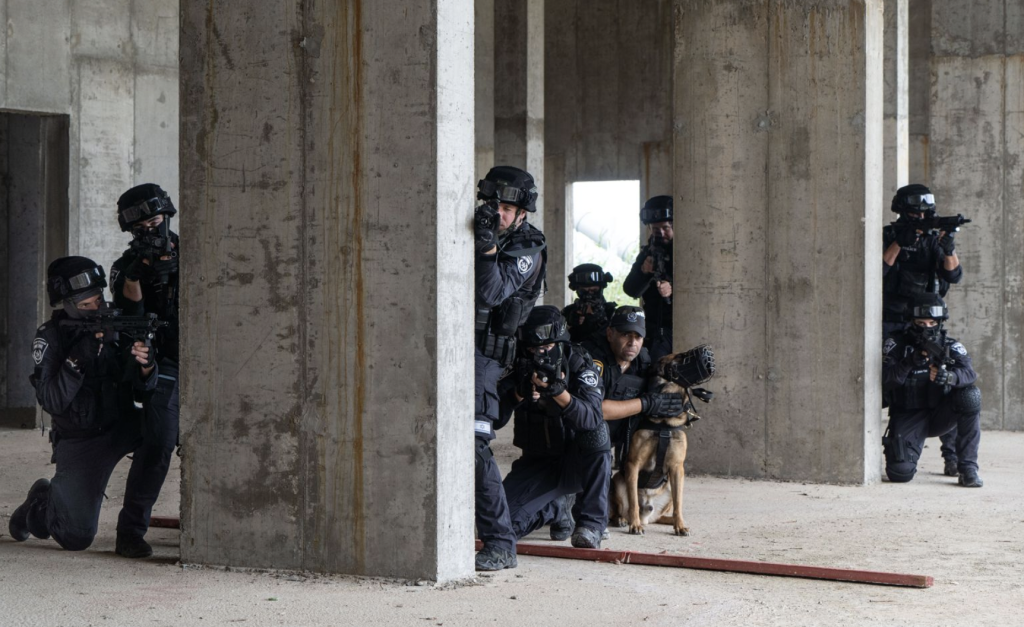
In the wake of withdrawing a key division from Gaza, the IDF continues to carry out training in northern Israel to prepare for escalation from Hezbollah or other Iranian-backed groups. The IDF has been training in the north since Hamas launched its attack on October 7, and Hezbollah began attacks on Israel the next day. After an initial call for 300,000 reservists, with many thousands of them sent north to bolster the army’s defenses against Hezbollah, the IDF settled into a training routine to prepare forces for a possible future battle.
The latest major training focused on the 146th reserve division and brought together Israeli police, search and rescue forces, the navy and air force and was geared toward “enhancing readiness on the northern border,” the IDF said on April 9. It focused on “multi-branch and multi-organizational cooperation.”
These trainings have taken many forms, including combined infantry, tanks and engineering battalions advancing on open ground in the Golan, where some of the terrain is similar to the challenges they may face in Lebanon. In addition, the IDF recently conducted a training led by the 36th division in late March. The 36th is an armored division that played a key role in Gaza in the first months of the war. Its 7th armored brigade was detached and sent to Khan Younis when the rest of the 36th left in Gaza and went north in mid-January and early February. That left the division with Golani infantry and the 188th armored. The 188th was asked to be partly responsible for a sector including Mount Meron and Mount Dov on the border of Lebanon and Syria. This gives a sense of Israel’s focus on the north.
The 36th led a training program that brought together commanders and officers in northern Israel. The program “included professional lectures and learning from the division’s combat lessons in the Gaza Strip, with specific adjustments for the challenges of the northern arena.” Now in April, the IDF’s 146th division is doing a different kind of training. The IDF characterizes the unit as its largest reservist division, and says it has been “operating in the Western Galilee region since the beginning of the war.”
The IDF focused on defensive operations and coordinating between the navy and ground forces, as well as evacuating the wounded under fire. “As part of the training, the joint security authorities of the Haifa arena practiced managing a variety of threats and operational scenarios that they might encounter in the northern maritime arena.” Helicopters and naval units based in Haifa were used in the extensive training, bringing together the kinds of units that would have to respond to any major war in the north. The IDF also coordinated with civilian local authorities. Israel evacuated around 80,000 people from northern Israel in October when Hezbollah began its attacks on Israel.
The IDF has focused a lot of resources on the north throughout the war in Gaza, because of concerns about a war with Hezbollah. Hezbollah is assumed to be stronger than Hamas, with more rockets and more lethal terrorist forces, such as its Radwan units. Hezbollah has taken losses in the six months of attacks on Israel. The IDF responds proportionately to these attacks, but every few days Hezbollah members are eliminated, leading to losses of over 200 men who are not easily replaceable because many had years of experience with the organization.
The training program of the 36th and 146th are not the only changes in the north. The IDF established a new Mountain Brigade in March. This unit is expected to take control of Mount Hermon and Mount Dov as a territorial unit under the 210th division which guards the Golan.
Israel’s Defense Minister Yoav Gallant held a call with US Secretary of Defense Lloyd Austin on April 8, in which Gallant “raised ongoing threats posed by Iranian aggression, including via Iranian proxy Hezbollah. They discussed coordination in the face of scenarios involving regional escalation.” Gallant has frequently highlighted the threat to northern Israel throughout the war in Gaza, keeping a focus on Hezbollah and the IDF’s preparations for escalation.







